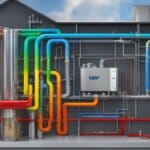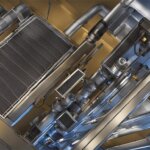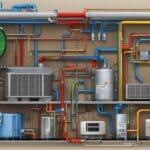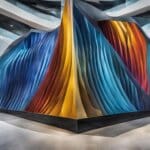Table of Contents
VRF, which stands for variable refrigerant flow, is a state-of-the-art HVAC solution that is gaining popularity among HVAC contractors, builders, and mechanical contractors. This technology offers energy efficiency, a quick return on investment, and customizable solutions for commercial spaces and facility managers.
VRF systems are ductless, large-scale HVAC systems that operate at a high capacity. They allow multiple indoor units to run on the same system, providing both heating and cooling simultaneously. This technology utilizes inverter compressors, which adjust the compressor’s capacity based on the specific needs of each space, resulting in significant efficiency gains.
With VRF systems, HVAC professionals can grow their businesses by offering a state-of-the-art solution to their clients. The ability to customize VRF systems to meet the specific requirements of any project makes it an ideal choice for commercial spaces, such as office buildings, hotels, and shopping centers. Facility managers can benefit from VRF technology’s energy efficiency and the potential for cost savings, while enjoying a comfortable indoor environment.
Next, we will explore how VRF systems work and the types available to cater to different needs. But before that, let’s take a look at the diagram below to get a better understanding of VRF:
Now, let’s delve into the inner workings of VRF systems in the next section.
How VRF Works and its Types
In a VRF system, the refrigerant passes through condenser units to indoor units, cutting down on the need for extensive ductwork and air handlers. This results in increased energy efficiency and decreased losses of cool air through ducts. VRF systems can be either heat recovery systems or heat pump systems, providing the ability to heat and cool simultaneously or heating and cooling at different times.
There are also different types of VRF systems available, including air-cooled and water-cooled systems. Air-cooled VRF systems rely on outside air, while water-cooled VRF systems use a water-source loop for heat recovery between compressor units.
VRF vs. VRV: What’s the Difference?
While VRF and VRV (Variable Refrigerant Volume) are often used interchangeably, there is a subtle distinction between the two. VRF refers to the large-scale system that provides variable refrigerant flow, while VRV is a trademarked term coined by Daikin, a leading HVAC manufacturer. Both systems operate in a similar manner, but VRV is a specific brand of VRF system.
The Advantages of VRF Systems
- Energy Efficiency: VRF systems are highly energy-efficient, reducing utility costs and environmental impact.
- Customizable: VRF systems can be tailored to the specific needs of each space, allowing for customizable temperature settings and improved comfort.
- Heat Recovery System: VRF systems with heat recovery capability enable simultaneous heating and cooling, optimizing energy usage.
- Heat Pump System: VRF heat pump systems provide efficient heating and cooling at different times, offering year-round comfort.
- Air-cooled and Water-cooled Systems: VRF systems come in different configurations to suit various applications and environments.
Benefits of VRF Systems
VRF systems offer numerous benefits over traditional HVAC systems. They are highly energy-efficient, resulting in cost savings on utility bills. They also provide customizable temperature settings, allowing for individualized control in different zones. VRF systems are sleek and compact, making them a great solution for retrofitting or limited spaces. They are highly scalable and can be used in a range of applications, from small homes to large commercial buildings. VRF systems are also known for their quiet operation, both inside and outside the building, and they are relatively easy to install compared to ducted HVAC equipment.
| Benefits of VRF Systems | Description |
|---|---|
| Energy Efficiency | VRF systems are highly energy-efficient, resulting in significant cost savings on utility bills. |
| Customizable Temperature Settings | VRF systems allow for individualized control and customizable temperature settings in different zones. |
| Sleek and Compact | VRF systems are designed to be sleek and compact, making them ideal for retrofitting or limited spaces. |
| Scalability | VRF systems can be easily scaled to meet the requirements of both small residential homes and large commercial buildings. |
| Quiet Operation | VRF systems operate quietly both inside and outside the building, ensuring a comfortable environment for occupants. |
| Easy Installation | Compared to ducted HVAC equipment, VRF systems are relatively easy to install. |
Image:
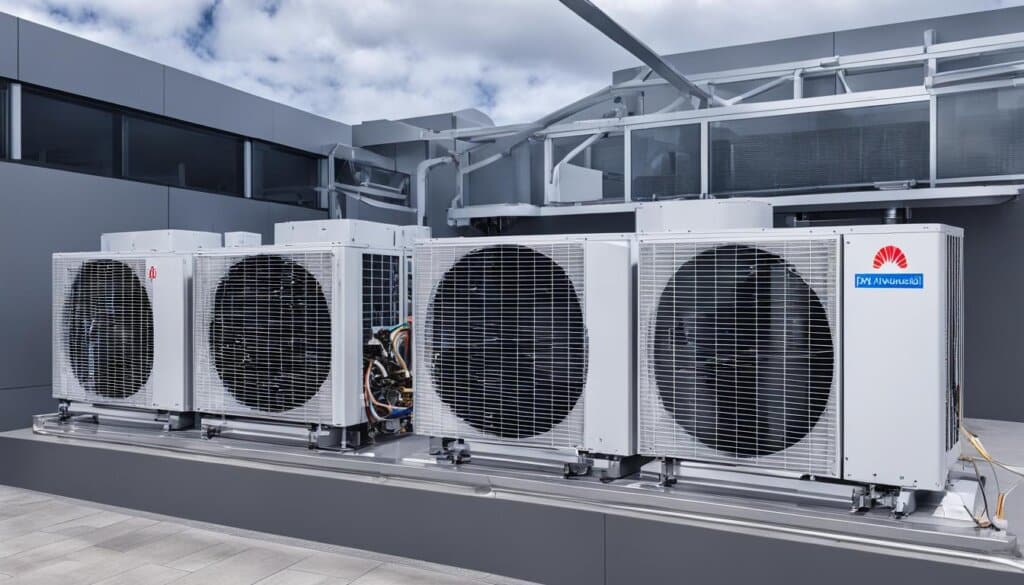
VRF in Virtual Routing and Forwarding
The versatility of Variable Refrigerant Flow (VRF) extends beyond heating, ventilation, and air conditioning (HVAC) systems. It is also a crucial component in virtual routing and forwarding (VRF) within IP network routers. By enabling multiple instances of a routing table in a virtual router, VRF enhances network security and connectivity. It is frequently employed by internet service providers (ISPs) to establish separate virtual private networks (VPNs) for their customers, ensuring secure and efficient data transmission.
Incorporating VRF systems in building projects demonstrates their potential contribution to achieving LEED certification. VRF systems are lauded for their remarkable energy efficiency and ability to maintain comfortable indoor air quality. Complying with ASHRAE standards, such as safety regulations for refrigeration systems and specific refrigerant designations, is a crucial aspect of implementing VRF systems. These systems also boast high energy efficiency ratios (EER) and integrated energy efficiency ratios (IEER), aligning with sustainability goals and promoting greener building initiatives.
As technology continues to evolve, the adaptation of VRF beyond HVAC systems showcases its versatility and reliability in various industries. Whether enhancing network security through virtual routing and forwarding or contributing to energy-efficient building designs, VRF is a multi-faceted solution that promises efficient operations, reduced energy consumption, and a sustainable future.
FAQ
What does VRF stand for?
VRF stands for variable refrigerant flow.
What is a VRF system?
A VRF system is a state-of-the-art HVAC solution that allows multiple indoor units to run on the same system, providing heating and cooling simultaneously. It is highly customizable and suitable for commercial spaces and facility managers.
How does a VRF system work?
VRF systems use inverter compressors that ramp up or down based on the needs of each space, resulting in substantial efficiency gains. The refrigerant passes through condenser units to indoor units, eliminating the need for extensive ductwork and air handlers.
What are the types of VRF systems?
VRF systems can be either heat recovery systems or heat pump systems. Heat recovery systems can heat and cool simultaneously, while heat pump systems heat and cool at different times. There are also air-cooled and water-cooled VRF systems, with air-cooled systems using outside air and water-cooled systems using a water-source loop for heat recovery.
What are the benefits of VRF systems?
VRF systems offer superior energy efficiency, resulting in cost savings on utility bills. They provide customizable temperature settings and individualized control in different zones. VRF systems are sleek, compact, and scalable, making them suitable for a range of applications. They operate quietly and are relatively easy to install compared to ducted HVAC equipment.
What is the use of VRF in virtual routing and forwarding?
In addition to HVAC systems, VRF is also used in virtual routing and forwarding in IP network routers. It enables multiple instances of a routing table to exist in a virtual router, increasing connectivity and network security. VRF is often used by internet service providers to create separate virtual private networks for customers.
Can VRF systems contribute to LEED certifications?
Yes, VRF systems can contribute to LEED certifications due to their high energy efficiency and ability to provide comfortable indoor air quality. They must comply with ASHRAE standards, including safety standards for refrigeration systems and designations for refrigerants. VRF systems have high energy efficiency ratios (EER) and integrated energy efficiency ratios (IEER), making them a sustainable choice for building projects.


